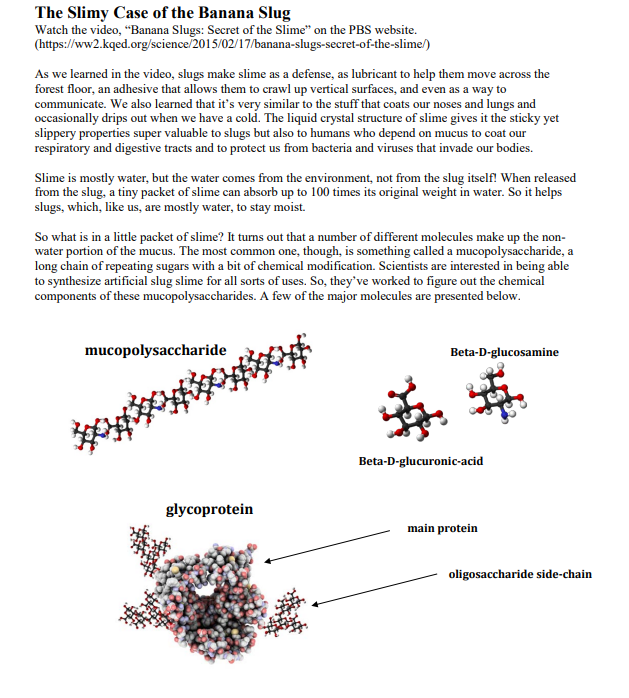Does mucous serve the same purpose in humans as in the banana slug? (Explain) 2. What potential uses can there be to discovering how to synthetically (in the lab) make banana slug mucous?
Does mucous serve the same purpose in humans as in the banana slug? (Explain) 2. What potential uses can there be to discovering how to synthetically (in the lab) make banana slug mucous?
Human Physiology: From Cells to Systems (MindTap Course List)
9th Edition
ISBN:9781285866932
Author:Lauralee Sherwood
Publisher:Lauralee Sherwood
Chapter3: The Plasma Membrane And Membrane Potential
Section: Chapter Questions
Problem 1ACR: When William H. was helping victims after a devastating earthquake in a region not prepared to...
Related questions
Question
1. Does mucous serve the same purpose in humans as in the banana slug? (Explain)
2. What potential uses can there be to discovering how to synthetically (in the lab) make banana slug mucous?

Transcribed Image Text:The Slimy Case of the Banana Slug
Watch the video, "Banana Slugs: Secret of the Slime" on the PBS website.
(https://ww2.kqed.org/science/2015/02/17/banana-slugs-secret-of-the-slime/)
As we learned in the video, slugs make slime as a defense, as lubricant to help them move across the
forest floor, an adhesive that allows them to crawl up vertical surfaces, and even as a way to
communicate. We also learned that it's very similar to the stuff that coats our noses and lungs and
occasionally drips out when we have a cold. The liquid crystal structure of slime gives it the sticky yet
slippery properties super valuable to slugs but also to humans who depend on mucus to coat our
respiratory and digestive tracts and to protect us from bacteria and viruses that invade our bodies.
Slime is mostly water, but the water comes from the environment, not from the slug itself! When released
from the slug, a tiny packet of slime can absorb up to 100 times its original weight in water. So it helps
slugs, which, like us, are mostly water, to stay moist.
So what is in a little packet of slime? It turns out that a number of different molecules make up the non-
water portion of the mucus. The most common one, though, is something called a mucopolysaccharide, a
long chain of repeating sugars with a bit of chemical modification. Scientists are interested in being able
to synthesize artificial slug slime for all sorts of uses. So, they've worked to figure out the chemical
components of these mucopolysaccharides. A few of the major molecules are presented below.
mucopolysaccharide
Beta-D-glucosamine
Beta-D-glucuronic-acid
main protein
glycoprotein
oligosaccharide side-chain
Expert Solution
This question has been solved!
Explore an expertly crafted, step-by-step solution for a thorough understanding of key concepts.
This is a popular solution!
Trending now
This is a popular solution!
Step by step
Solved in 3 steps

Knowledge Booster
Learn more about
Need a deep-dive on the concept behind this application? Look no further. Learn more about this topic, biology and related others by exploring similar questions and additional content below.Recommended textbooks for you

Human Physiology: From Cells to Systems (MindTap …
Biology
ISBN:
9781285866932
Author:
Lauralee Sherwood
Publisher:
Cengage Learning

Biology Today and Tomorrow without Physiology (Mi…
Biology
ISBN:
9781305117396
Author:
Cecie Starr, Christine Evers, Lisa Starr
Publisher:
Cengage Learning

Human Biology (MindTap Course List)
Biology
ISBN:
9781305112100
Author:
Cecie Starr, Beverly McMillan
Publisher:
Cengage Learning

Human Physiology: From Cells to Systems (MindTap …
Biology
ISBN:
9781285866932
Author:
Lauralee Sherwood
Publisher:
Cengage Learning

Biology Today and Tomorrow without Physiology (Mi…
Biology
ISBN:
9781305117396
Author:
Cecie Starr, Christine Evers, Lisa Starr
Publisher:
Cengage Learning

Human Biology (MindTap Course List)
Biology
ISBN:
9781305112100
Author:
Cecie Starr, Beverly McMillan
Publisher:
Cengage Learning